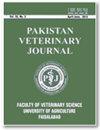Immunocytochemical Detection of Kisspeptin Receptor and Its Association with Motility of Buffalo Bull (Bubalus bubalis) Spermatozoa
IF 5.4
3区 农林科学
Q1 VETERINARY SCIENCES
引用次数: 5
Abstract
Received: Revised: Accepted: Published online: November 11, 2019 December 11, 2019 December 15, 2019 January 21, 2020 Kisspeptin is a powerful regulator of the hypothalamic-pituitary-gonadal axis. It acts through its receptor GPR54 to regulate sexual maturation, oogenesis, spermatogenesis and fertilization. The present research was implemented to evaluate the presence of kisspeptin receptor on various regions of buffalo bull spermatozoa and to decipher its relationship with different motility parameters of the fresh spermatozoa. Standard swim-up protocol was performed on fresh ejaculates from Nili-Ravi buffalo bulls to obtain three hypothetical layers, having spermatozoa with enhanced motility and normal morphology. The progressive sperm motility was measured in each layer by using phase contrast microscopy. Methanol fixed sperm smears from each layer were processed for standard immunocytochemistry procedure for the detection of kisspeptin receptor using specific antibodies. Maximum GPR54 immunoreactivity was observed in the upper regions (head, neck/midpiece) and moderate immunoreactivity was seen in the lower region (tail) of the spermatozoa in all the three layers. No significant difference in total GPR54 expression was observed in the spermatozoa from three layers and no relationship was observed between percentage motility and GPR54 like ir. Present findings suggest that the buffalo sperm motility is not influenced by GPR54 expression on different regions of the sperm. However, robust GPR54 expression in dorsal areas of buffalo sperm, would raise possibility of a covert function of kisspeptin in the bubaline sperm biology. ©2019 PVJ. All rights reservedKisspeptin受体的免疫细胞化学检测及其与水牛精子活力的关系
接收:修改:接收:在线发布:2019年11月11日2019年12月11日2019年12月15日2020年1月21日Kisspeptin是下丘脑-垂体-性腺轴的强大调节剂。它通过受体GPR54调节性成熟、卵子发生、精子发生和受精。本研究旨在评价kisspeptin受体在水牛精子不同部位的存在,并分析其与新鲜精子不同运动参数的关系。对Nili-Ravi水牛的新鲜射精进行标准的游泳程序,以获得三层假设的精子,这些精子具有增强的运动性和正常的形态。用相差显微镜测定每层精子的进行性运动。每层甲醇固定精子涂片经标准免疫细胞化学程序处理,使用特异性抗体检测kisspeptin受体。三层精子上部(头、颈/中段)GPR54免疫活性最高,下部(尾)GPR54免疫活性中等。三层精子中GPR54的总表达量无显著差异,运动率与GPR54的表达量无显著相关。目前的研究结果表明,水牛精子的活力不受精子不同区域GPR54表达的影响。然而,GPR54在水牛精子背侧区域的强烈表达,将提高kisspeptin在雄性精子生物学中的隐蔽功能的可能性。©2019 PVJ。版权所有
本文章由计算机程序翻译,如有差异,请以英文原文为准。
求助全文
约1分钟内获得全文
求助全文
来源期刊

Pakistan Veterinary Journal
兽医-兽医学
CiteScore
4.20
自引率
13.00%
发文量
0
审稿时长
4-8 weeks
期刊介绍:
The Pakistan Veterinary Journal (Pak Vet J), a quarterly publication, is being published regularly since 1981 by the Faculty of Veterinary Science, University of Agriculture, Faisalabad, Pakistan. It publishes original research manuscripts and review articles on health and diseases of animals including its various aspects like pathology, microbiology, pharmacology, parasitology and its treatment. The “Pak Vet J” (www.pvj.com.pk) is included in Science Citation Index Expended and has got 1.217 impact factor in JCR 2017. Among Veterinary Science Journals of the world (136), “Pak Vet J” has been i) ranked at 75th position and ii) placed Q2 in Quartile in Category. The journal is read, abstracted and indexed internationally.
 求助内容:
求助内容: 应助结果提醒方式:
应助结果提醒方式:


